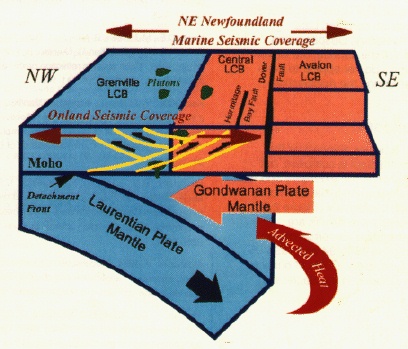The opening and closing of ocean basins is
a fundamental process in the continuing evolution of the Earth.
The island of Newfoundland, the focus of this transect, owes
its geological configuration to the opening and closing of
the ancient Iapetus Ocean during the Paleozoic (~600-275 Ma).
With the subsequent opening of the Atlantic Ocean during the
Mesozoic (~165-90 Ma), a process spatially offset from the
suture zone formed by Iapetus closure, the Appalachian orogen
was established along eastern North America.

Map of Newfoundland Appalachians showing tectonostratigraphic
zonations, simplified geology and location of onland LITHOPROBE
seismic corridors.
The LITHOPROBE East Transect investigates these processes
through studies in and around Newfoundland. Interpretation
of the extensive marine and onshore geophysical data reveals
at least two lower crustal blocks, perhaps associated with
the Laurentian (Grenville of North America) and Gondwanan (of
African affinity) plates, overlain by allochthonous tectonostratigraphic
domains established previously on the basis of surface geological
studies. Integration of the multidisciplinary data has led
to the development of a model for crustal evolution that involves
continent-continent collision between Lurentia and Gondwana
as Iapetus closed, with detachment and underthrusting of the
subcrustal lithosphere of the Laurentian plate. Oceanic crust
of Iapetus was obducted onto the crustal blocks. On the rifted
Atlantic margin, marine seismic studies have established two
basin styles that differ markedly in structure and stratigraphy
from one region to another, results being used by the petroleum
industry. At the present ocean-continent transition, interpretations
suggest underplating of thinned continental crust by basaltic
melt during the rifting process. LITHOPROBE studies have significantly
altered previous models for evolution of the Newfoundland Appalachians
and are providing a more comprehensive understanding of the
processes and structures involved in that evolution.

Simple schematic describing collision between the Laurentian
and Gondwanan plates based on LITHOPROBE results
Publications
LITHOPROBE East Transect Reports |
